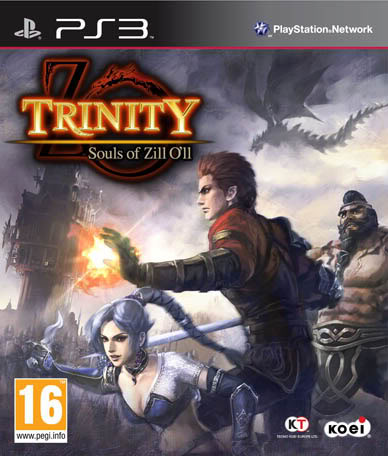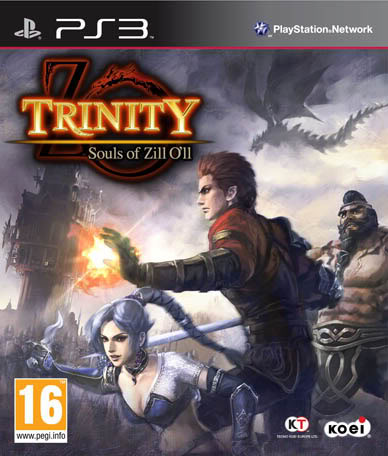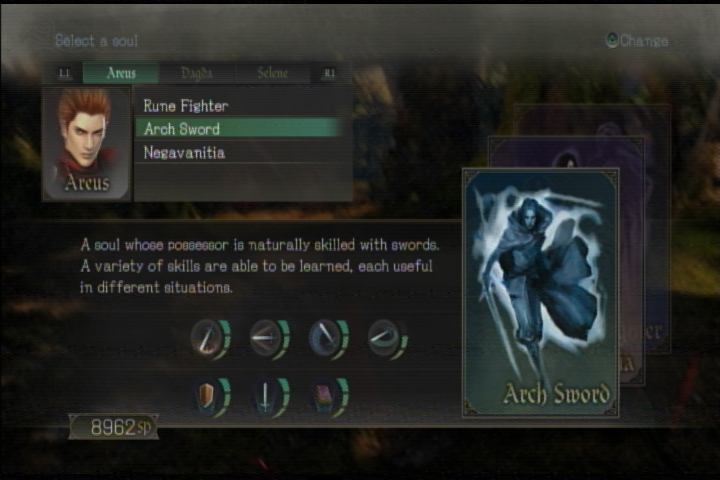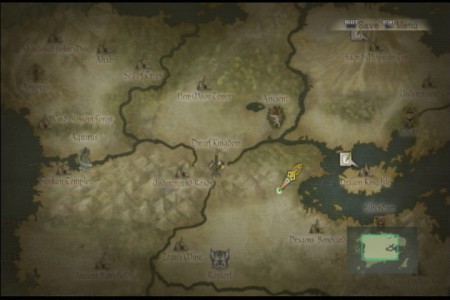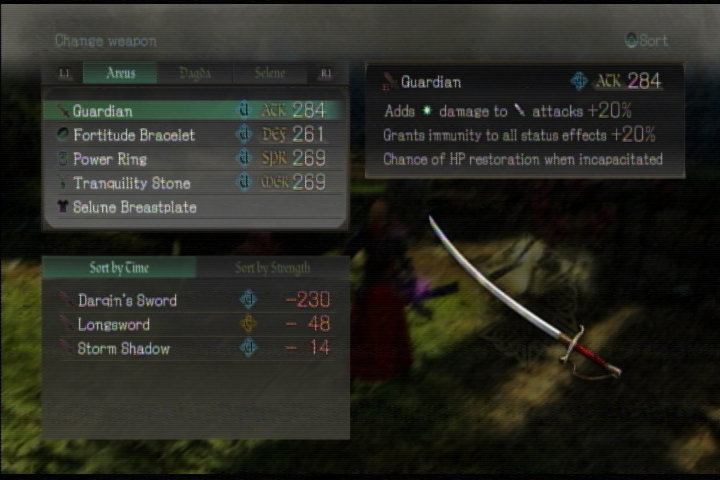Trinity: Souls of Zill O’ll
Publisher: Tecmo Koei
Developer: Omega Force
Genre: Action RPG
Platform: Playstation 3
Release date: (NA) February 8th, 2001 (EU/AU) February 11th
Price: (NA) $59.99 (EU) £39.99 (AU) $89.99
Trinity: Souls of Zill O’ll most likely has been under the radar for most gamers. It’s a game with a weird name that wasn’t advertised very much that came straight out of Japan. What most gamers don’t know, however, is that this is actually the latest game in the Zill O’ll franchise which has, up until now, been only available in Japan. From what I understand this game is unique in its gameplay apart from the rest of the series. Many were expecting this game to be a budget title, but it is far from it. Despite it’s weird name, Trinity: Souls of Zill O’ll will surprise gamers with its staggering amount of content, excellent sense of progression and unique gameplay.
Story
The story admittedly starts slow and you initially won’t hold much interest in the characters or their reasons for advancing the story. The main character, Areus, is the (secret) grandchild of an evil emperor, Lord Balor, who was prophesied to be his downfall. As such, Balor had his pregnant daughter murdered. Unbeknownst to him, though, is that his son had already had a child (Areus) who has managed to escape his fate at the hands of Balor’s henchmen.
An adult Areus joins the Arena (a perfect way to present you the tutorial) and rises up through the ranks with his friend, Dorado. On the sly, Areus is using the arena to build his combat skills to prepare for fighting Balor. Eventually Areus tires of the Arena and begins taking on guild quests from various towns. Along the way he meets two other warriors, a Boldan named Dagda (basically giant-people) and a Darkenith named Selene (vampire). The three agree to become mercenaries for the Dyneskal Army (Lord Balor’s army) under General Dorado (Areus’s friend from the arena joined the army and became a high ranking general) in an attempt to get close to Balor to make a strike.
Eventually Dorado gives Areus a special request to find and eliminate a rogue group of warriors who are gathering to stop Balor. Areus and crew seek them out, join forces and collaborate to end Balor. Along the way they take down a few stragglers who aim to aid Balor or at the very least impede Areus. Plot twists and drama occur during the length of all of this. The story is nothing new, but it serves it’s purpose. At about halfway the story starts to get pretty interesting and I found myself playing to simply further the story instead of unlocking more of the game.
There is a great deal of backstory and lore (as this is part of a long running series in Japan). The game sports a bestiary that lists the weaknesses as well as a bit of backstory for every monster you defeat. Along with this bestiary is also a journal that records various legends and lore that you find out throughout the game’s taverns and character interactions. There is a great deal of discovery waiting to be had here, though none of it is mandatory. If you desire to learn more about the game world, it’s there to be had.
Despite the decent storyline, the voice acting for the cutscenes can be dreadfully awful for some characters. Areus, Dagda (the boldan) and Dorado seem to hit their mark, but almost the entirety of the remainder of the cast are absolutely awful and can really serve to pull you out of the game.
Gameplay
The combat, at its core, is hack and slash. This was developed by Omega Force, famed developers of the Dynasty Warriors franchise and so you can definitely see its roots and inspirations here. Initially you only have Areus to play as, but as said earlier, you eventually gain 2 more party members. The unique gameplay element for Trinity is that you are able to switch between characters at will, even mid combo. The other 2 characters are AI controlled and will suffer a noticeable hit to their damage but will also become much more resistant to damage.
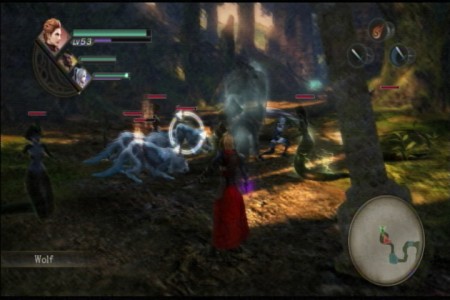 In addition to fighting while you control one character, the remaining 2 AI controlled characters can grant you a bonus during battle, depending on who is AI controlled. Areus can grant increased attack power, Dagda will make you invulnerable and Selene will grant you life-sucking ability on your weapon. These buffs only last about 30 seconds and are randomly cast at the beginning of battles. They aren’t much but they do help out quite a bit.
In addition to fighting while you control one character, the remaining 2 AI controlled characters can grant you a bonus during battle, depending on who is AI controlled. Areus can grant increased attack power, Dagda will make you invulnerable and Selene will grant you life-sucking ability on your weapon. These buffs only last about 30 seconds and are randomly cast at the beginning of battles. They aren’t much but they do help out quite a bit.
Once you gain all three party members, you are able to “break” certain monsters, mainly bosses and mini-bosses. What this means is that after one of these enemies does an attack, a glowing reticle will appear around them and shrink down. This reticle means that they are currently vulnerable and if you hit them with an element they are weak against it will begin to “break” them. Once you initiate this, the reticle will grow larger, giving you more time to break the enemy. Once broken, the enemy falls down for around 15-30 seconds, taking much more damage than usual (this is normally the only way to kill these monsters). If they get down to 20-30% health during a break state, you can initiate a trinity attack, using all three fighters to finish it off and netting you bonus experience.
Combat is real time, much like Dynasty Warriors. You can buy new skills and abilities from the various mage’s guilds across the gameworld or learn certain ones for completing specific quests. These skills and abilities can be leveled up twice by spending souls (experience) that you earn for defeating enemies. These skills and abilities can be freely mapped to either the square, triangle or circle buttons, using R2 to switch to another set of abilities. Unfortunately, there are something like 12 skills for every character and 6 total slots just isn’t enough. I would have liked a bit more room for customization in that area as it does get hard to juggle all of these different elements and attacks for each individual enemy.
The game has two difficulty settings, easy and normal. I played through on normal, and it felt right. The majority of fights against trash mobs (lesser enemies) were often not a problem, though certain enemy types can prove to be a nuisance. There were some fights that were legitimately challenging which were quite apropos, mainly consisting of bosses or new enemy types that can throw you a curveball. Needless to say, unless you spend hours upon hours grinding so you are vastly above the appropriate level, the game has a nice balance of challenge throughout.
Each level generally plays out as “go from point A to point B and find a special item or kill a boss at point B”. As you progress the story you unlock more towns and dungeons (I say dungeons, this really means any playable level), sometimes even unlocking completely new areas within already discovered dungeons. There are TONS of guild quests and honestly they can get somewhat repetitive fairly quickly. You can only do the same level so many times, even if it is for different reasons like finding an item, killing a boss or escorting an NPC (yes, there are escorts and yes, escorts are the bane of video games) it will still wear on your enthusiasm.
Unfortunately, there is no “travelling”. There is no overworld. It’s simply a map that you look at and move a cursor around to select where you want to go. Towns are not a playable space, only a menu. From the map you select a town, the town background loads and you are able to select where to go in the town, be it the adventurer’s guild, mage’s guild, tavern, shop or other areas. All character interaction is done through text with the characters portraits appearing on screen, much like RPG’s of yore. I do wish that there was more polish in this, like actually being able to visit towns and move around, physically talk to the NPC’s but honestly the way they do it evokes a great sense of nostalgia for me. I can understand that this won’t happen for other people and can see how it would be a great let down.
Presentation
Trinity: Souls of Zill O’ll was once advertised to use a unique and innovative art style to make it look as if the game was a moving oil painting. It’s actually just a filter over the screen that is instantly noticeable. Not that it looks bad, but this is not an art style. It’s simply 3D graphics with translucent filter over it. Zelda: Wind Waker was a completely new art style, this is not. Again, it doesn’t look bad but it’s nothing to get excited about.
There is no armor, but you do change bracelets, rings and necklaces. What I’m saying is, visually, you do not change aside from weapons. You DO unlock one new costume/outfit within the game, simply an upgrade of their basic clothing, but this does nothing for your stat-wise, it’s just for looks. Japan got a great deal of DLC, ranging from new areas, dungeons, quests, items and outfits, but it seems that the West is not getting any of this. Peculiar that it wasn’t included on disc, as most if not all of it was free and was already made (as this has been out in Japan for months) but hey, whatever.
There are a handful of weapon models, making finding a new weapon fun to see what it’s going to look like. Weapons follow a pretty traditional style, randomly generated bonus’s. Examples would be “rapier of heroism” or “fists of stone” or “daggers of venom”. There are special weapons and items that you can get from quests or very rare drops that are unique and often have a unique model with way above average stats, so it’s not just all generic crap.
For a game that is easily 30+ hours long, you would expect to not be fighting the same 5 enemies over and over again. The game does re-use models, but there are enough unique types so that you don’t get bored. Each level and environment will be home to a plethora of creatures that can change based on what quest you are on, so you never need to worry about getting bored in that sense. Even 20-30 hours in you are still discovering completely new types of enemies.
If you frequent taverns and guild halls you will eventually unlock hidden sidequests for yourself and your teammates. Completing these will significantly upgrade that character, unlocking a completely new set of skills and abilities they are able to learn. This simple mechanic of rewarding the player for exploring and discovering new things is present throughout the entirety of the game, so you should always check the towns any new things that might have popped up.
Constant checking of the taverns and towns will serve to unlock not only quests for your characters but a plethora of other sidequests. You can eventually unlock a casino later in the game to win special equipment as prizes, progress through the arena to unlock powerful weapons from defeating the bigger bosses and discover a great deal of smaller sidequests from random NPC’s.
The game’s pacing and sense of progression is absolutely astounding. I can’t write this review without emphasizing this. The game will take around 35-40 hours to complete, longer if you want to platinum it and unlock everything. ALL along the way you are being introduced to new core game mechanics and discovering new things. Around 20 hours in you unlock a new method of combat that will completely change how you fight bosses. It’s really great to see things like this because games normally introduce most if not all core mechanics in the tutorial or very early in the game, it’s quite refreshing to find new stuff even 20-30 hours in. Just when you think you’ve peaked and are just going to spend the rest of the game grinding on the same enemies, the game switches it up to keep it fresh.
Final thoughts
For a franchise that is seemingly out of the blue, this game absolutely astounded me at its sheer amount of content and (adequate) level of polish. The game isn’t perfect, the voice acting is pretty bad in parts, quests can become very repetitive and the game seems to run a bit too long when you near the end. It’s also a bit disappointing to see so many unique characters throughout the story who are unplayable. You would think that with a developer like Omega Force who make a game like Dynasty Warriors with dozens of playable, unique characters, they would allow you to play with the other characters in this game, but nope. You are always stuck with the same 3, the other characters will come in as guests but you can’t control them, which is a bit of a shame. But despite these flaws, Omega Force has pumped out a pretty great action RPG aside from their usual Dynasty Warriors (which are also awesome, by the way). Gamers will be hard pressed to find another game with this level of content and excellent sense of progression that rewards the player for exploring the game’s lore.
For its debut appearance in the West, the Zill O’ll universe has surprised me a great deal. Here’s to hoping they localize more of this franchise down the road. If you are a fan of action RPG’s and are looking for something that will gives a good “bang for your buck”, then check out Trinity: Souls of Zill O’ll.
Trinity: Souls of Zill O’ll gets…



